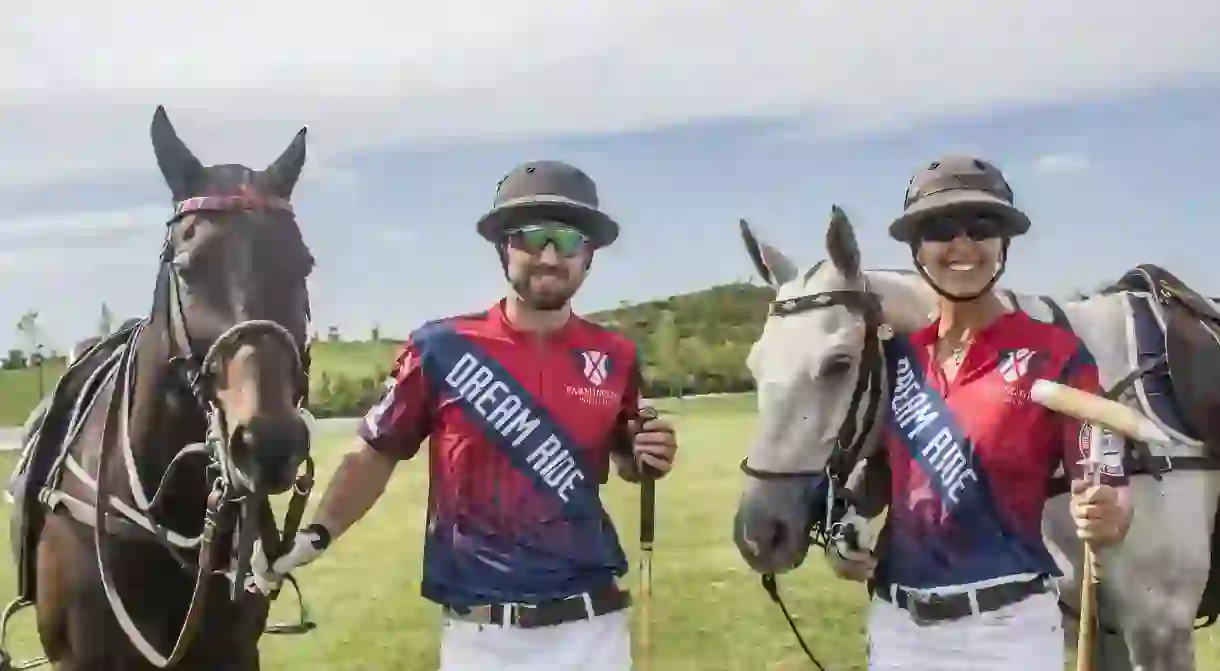Common Misconceptions About Polo Debunked

Farmington Polo Club members Jennifer Williams and Patrick Marinelli were in New York City last week ahead of the Victory Cup Fall NYC Classic on Sept. 23. The pair, who have different sporting and polo backgrounds, talked about some common misconceptions when it comes to “The Sport of Kings”.
Polo isn’t for everyone
False. While polo, which can trace its roots as far back as sixth century Persia, was predominantly a sport for rich men, the game has become more accessible in recent years to women and younger players. According to the United States Polo Association, approximately 40 percent of its members are women.
“Usually, people need to have a little more time to invest into it—their job is tapering off, their kids are older—so that’s why you find the majority of people were men in their 50s,” Williams said. “That’s changing drastically; there are a ton of women in polo and there are a lot of young kids playing.”
There is an ideal body type
False. One might be able to correctly guess who is a basketball player or football player based on their size or physique, but polo players don’t stand out as much, if at all. There is no ideal polo body type, only a much-needed mentality of keeping your cool while striding as fast as 40 mph on a horse with a mallet in hand.
“You won’t see someone and be like, ‘Yeah, he’s a polo player,'” Williams said. “You’d be shocked as to who the people are that are extremely good—they might have no muscle or be a little shorter, but can ride around like no other and hit the ball 100 yards. There’s no body type.”
Mallets go in your right hand
True. Whether you’re left-handed, right-handed or ambidextrous, all polo players are required to hold their mallet in their right hand. The rule was created in the 1930s for safety reasons, but was rescinded following World War II. It was reinstated in 1974. According to the USPA rule book (Rule 28-e): “All players shall play with the mallet with their right hand, with the exception of left-handers registered with the USPA prior to January 1, 1974.”
“You might have a greater learning curve as a lefty, but there are a ton of great professional polo players who make a living playing with their right hand and writing with their left hand,” Williams said.

Players own their own horses
False. Again, going back to the “only rich people can play polo” myth, this is untrue. Nowadays, players are able to rent, lease or borrow horses to ride and play with. Some collegiate programs lease their horses out to adults to learn on and ride in order to help pay for their program. While having your own horse(s) and stable would be convenient, there are certainly ways to still play polo without your own steed in your stable.
“There are even non-profit groups like Work to Ride in Philadelphia which help inner-city kids have alternative means of spending their time,” Williams said. “They learn about responsibility, they learn about horses, they learn polo skills … Some have even gone on to be polo club managers or polo professionals.”
The ball is hit with the mallet face
False. While a polo mallet may look similar to a croquet mallet, they are utilized in different fashions. In croquet, the player hits the ball with the face of the mallet, while in polo, a player uses the larger surface area on the side, forming an upside down T when lining up his or her shot.
“In the middle is the sweet spot,” Williams said. “Thankfully we don’t use the face; there’s a little more surface area on the side.”
No prior riding experience is necessary
True. While having prior riding experience would certainly be a plus, it isn’t necessary when first getting into polo. Polo players can have a variety of sporting backgrounds—motocross, football, lacrosse—and still succeed on a horse. Even if you are a good rider, you can still improve after years of playing experience.
“I got bucked off a few times and it wasn’t really fun for me,” Marinelli said. “When I finally got back into it when I was 14 and really started riding, that’s when I committed and really started enjoying it … I kind of naturally had pretty good hand-eye coordination from football, so the riding was the most difficult thing for me to learn. My riding is always improving—it’s not something you ever really attain perfection in. It’s kind of a goal to always keep pushing forward and that’s one thing I really like about polo—you can always get better.”













